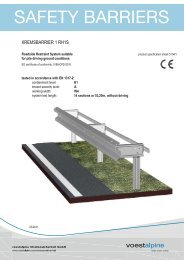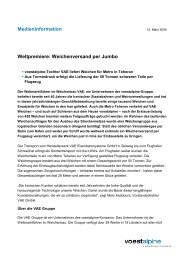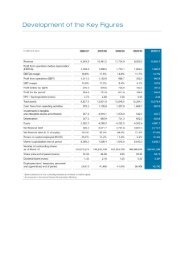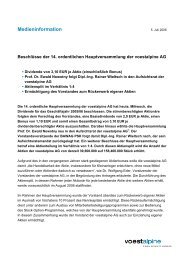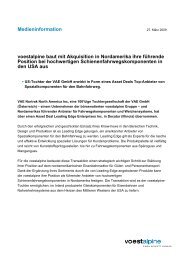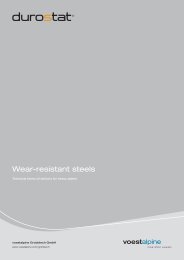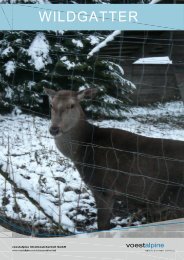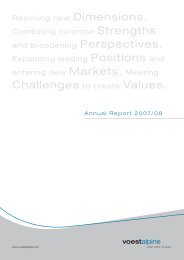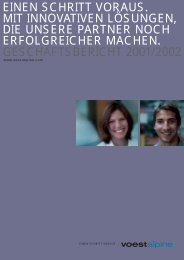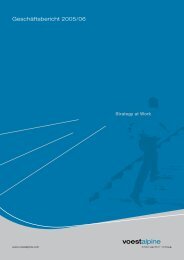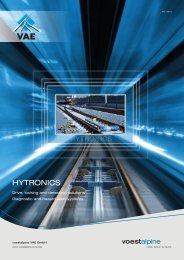Environmental Statement 2012 (3.25 MB) - voestalpine
Environmental Statement 2012 (3.25 MB) - voestalpine
Environmental Statement 2012 (3.25 MB) - voestalpine
Create successful ePaper yourself
Turn your PDF publications into a flip-book with our unique Google optimized e-Paper software.
<strong>voestalpine</strong> VAE GmbH<br />
<strong>voestalpine</strong> Weichensysteme GmbH<br />
<strong>voestalpine</strong> HYTRONICS GmbH<br />
www.<strong>voestalpine</strong>.com/weichensysteme<br />
updated<br />
<strong>Environmental</strong> <strong>Statement</strong> <strong>2012</strong><br />
Zeltweg Location<br />
<strong>Environmental</strong> Protection. Climate Protection. Health Protection. Employee Protection.
ANNUALLY UPDATED ENVIRONMENTAL STATEMENT<br />
in accordance with the Directive (EG) No. 1221/2009 (“EMAS III Directive”) of the European Parliament and the<br />
Council from November 25, 2009 concerning the voluntary participation of organisations in a joint environmental<br />
management and environmental operational auditing system (EMAS).<br />
The <strong>Environmental</strong> <strong>Statement</strong> <strong>2012</strong> contains an update concerning changes within the company and projects and<br />
data of environmental relevance. The <strong>Environmental</strong> <strong>Statement</strong> of the <strong>voestalpine</strong> location in Zeltweg also<br />
incorporates integrated aspects, projects and data relating to employee protection (health and safety).<br />
In line with the EMAS III directive, the <strong>Environmental</strong> <strong>Statement</strong> <strong>2012</strong> is connected to the <strong>Environmental</strong> <strong>Statement</strong><br />
2011, which contains a description of the location, the products, general environmental issues and successfully<br />
completed environmental projects.<br />
Contact:<br />
Manfred Torschitz<br />
Head of the Health, Safety, Environment & Energy Strategy Department (HSEE)<br />
Alpinestrasse 1, 8740 Zeltweg, Austria<br />
T: ++43/50304-28-350,<br />
manfred.torschitz@<strong>voestalpine</strong>.com<br />
In addition, company environmental statements can also be studied on our homepage:<br />
http://www.<strong>voestalpine</strong>.com/weichensysteme
Contents<br />
INTRODUCTION OF THE BOARD OF DIRECTORS 1<br />
ENVIRONMENTAL, HEALTH AND SAFETY OBJECTIVES & SUCCESSES 3<br />
Examples of measures implemented in <strong>2012</strong> 9<br />
FACTS AND FIGURES FOR THE LOCATION <strong>2012</strong> 15<br />
Input/output balance and core indicators 15<br />
Water 17<br />
Water 17<br />
Wastewater 17<br />
Transport 18<br />
Air 19<br />
Dust 19<br />
Volatile organic carbons (VOC) 19<br />
Other emissions 20<br />
Energy and CO 2 21<br />
Waste 23<br />
Use of plant area 24<br />
Accidents 25<br />
GENERAL INFORMATION 27<br />
Your discussion partner 28<br />
Entry into the organisational roster and date of<br />
the next <strong>Environmental</strong> <strong>Statement</strong> 28<br />
Awards 28<br />
Key words - abbreviations 29<br />
Validation and certificates 31<br />
Imprint 31
1<br />
INTRODUCTION OBJECTIVES/SUCCESSES FACTS/FIGURES GENERAL INFORMATION<br />
INTRODUCTION OF THE BOARD OF DIRECTORS<br />
With the <strong>2012</strong> <strong>Environmental</strong> <strong>Statement</strong> we hope to provide you with interesting information<br />
regarding current data and company activities of environmental and safety relevance at the<br />
<strong>voestalpine</strong> location in Zeltweg.<br />
This year witnessed the targeted reworking and improvement of the Zeltweg location’s fire<br />
protection and extinguishing water concept. The extinguishing water requirement calculation<br />
was updated, new roof fire sections were determined and a new extinguishing water pipe installed<br />
for the optimum design and implementation of the necessary extinguishing water supply. This<br />
is fed from the high-pressure pipeline of the location’s small-scale hydropower plant, which has<br />
allowed us to implement an ideal solution and attain security of supply, as owing to inherent<br />
pressure this system does not require any pumps or an external power source.<br />
In addition, we were once again able to successfully implement measures for enhanced energy<br />
efficiency (renovation of the BG 6+7 roof, the use of waste heat for ventilation), reduced dust levels<br />
(new extraction and filter system for butt welding) and improved ergonomics (renovation of the<br />
changing room and sanitation amenities for 150 employees).<br />
As reported extensively in the <strong>Environmental</strong> <strong>Statement</strong>s of recent years, a long-term energy<br />
concept based on energy savings and efficiency, CO 2 -neutral biomass-fired district heating and<br />
CO 2 -free electricity supply from our small-scale hydropower plant has already been implemented<br />
at our Zeltweg location. Consequently, we have created an ideal foundation for the accreditation<br />
of an energy management system pursuant to ISO 50001 and this has been set as a target for the<br />
end of 2013.<br />
From the perspective of the holding company and with a view to the international subsidiaries, the<br />
successful accreditation of the Turkish subsidiary VADEMSAS in accordance with ISO 14001<br />
and OHSAS 18001 in October <strong>2012</strong> is to be regarded as a very special highlight and we wish<br />
to offer our sincere congratulations to the management and personnel at this location, which is<br />
located roughly 150 km north of Ankara.<br />
An equally outstanding achievement is the successful conclusion of the extensive soil and ground<br />
water remediation measures at the former “milling cycle line” at the Brandenburg location in<br />
teamwork with Deutsche Bahn. A contaminated area has been replaced by jobs and a hall has<br />
been put into operation on the same site, which contains the “turnout grinding” services centre.<br />
The Board of Directors would like to thank all our competent and committed employees, who<br />
through their ideas and efforts have made these successes possible.
INTRODUCTION OBJECTIVES/SUCCESSES FACTS/FIGURES GENERAL INFORMATION<br />
<strong>voestalpine</strong> VAE GmbH<br />
Dieter Fritz Johannes Rainer Oswald Werner Saringer<br />
(Spokesperson) (CEO) (CEO)<br />
<strong>voestalpine</strong> Weichensysteme GmbH<br />
Wolfgang Schriefl Helmut Kreiter<br />
(Spokesperson) (CEO)<br />
<strong>voestalpine</strong> HYTRONICS GmbH<br />
Josef Winter Johannes Kreinbucher<br />
(Spokesperson) (CEO)<br />
2
3<br />
ENVIRONMENTAL, HEALTH AND SAFETY<br />
OBJECTIVES & SUCCESSES
INTRODUCTION OBJECTIVES/SUCCESSES FACTS/FIGURES GENERAL INFORMATION<br />
The following is an overview of the status and implementation of our activities in the<br />
HSEE field and above all, our objectives for the coming years. Naturally enough, the<br />
programme of measures is subject to continuous further development in line with the<br />
knowledge and requirements emanating from ongoing operations and we are pleased<br />
to state that during this year we were once again able to pinpoint additional challenges,<br />
which have already largely been dealt with successfully.<br />
Abbreviations:<br />
vaW = <strong>voestalpine</strong> Weichensysteme GmbH, vaH = <strong>voestalpine</strong> HYTRONICS GmbH, VAE = <strong>voestalpine</strong> VAE GmbH (Holding), StZ = joint, superordinated<br />
activities at the Zeltweg location<br />
Measure Objective or success Realisation<br />
WATER/WASTEWATER<br />
Elimination of process wastewater at the<br />
Zeltweg location (StZ)<br />
Renewal of approx. 300m of drinking water<br />
piping (StZ)<br />
AIR (DUST, VOC, ETC.)<br />
Optimisation of the extractor/filter system of<br />
the welding robot in BG 7 (vaW)<br />
Optimised extraction/filter system for both<br />
“submerged arc welding” workplaces in BG7<br />
(vaW)<br />
Optimised central extraction for insulated rail<br />
joint and slide rod bonding in BG11 (vaW)<br />
Installation of automatic underpressure<br />
controls in the filter systems (vaW)<br />
Measures already completed<br />
Newly established measures<br />
Measures that proved impossible or were substituted<br />
The introduction of an induction heating system that<br />
will eliminate the last production phase at the location<br />
to emit wastewater (to date approx. 1,700 m³/y required<br />
for descaling); consequently only sanitation and cooling<br />
water at the location<br />
Plant already built; authorisation processes for the<br />
changeover are in progress and will continue up to<br />
2013<br />
Replacement of the roughly 60-year-old DN 150<br />
pipeline, which saves leaks and well pump power<br />
Reduction of the ambient dust impact by approx. 60%<br />
The very latest dust and fine dust filter system with<br />
>99.9% removal levels also facilitates circulatory air<br />
conduction; resultant annual savings of 16 MWh of<br />
heating energy and approx. 3.1t CO 2<br />
Central extraction with specially adapted hoods<br />
instead of individual extractors for the tacking and<br />
fixing working phases<br />
Travelling spot extractions along the welding seam<br />
Optimised capture with a 40% reduction in impact on<br />
the employees and the surrounding hall area<br />
Clean air values < 1 mg/Nm³, 99.9% removal level with<br />
energy-saving air recirculation<br />
Heating savings of approx. 35 MWh corresponding<br />
prevention of approx. 7 t CO 2 emissions/year<br />
Merger of the previously separated working areas<br />
250% increase in extraction capacity and doubling of<br />
the extraction points<br />
Explosion-protective design of the extraction system<br />
Optimum capture of solvents in the work areas by<br />
means of table extraction<br />
Underfloor piping installation to prevent the danger of<br />
tripping<br />
Automatic control of extractor performance for<br />
optimum dust capture in the work areas (without<br />
draughts), as well as optimum energy consumption (via<br />
frequency converter controlled motors)<br />
July 2013<br />
July <strong>2012</strong><br />
March 2011<br />
March <strong>2012</strong><br />
March 2011<br />
March 2011<br />
4
5<br />
INTRODUCTION OBJECTIVES/SUCCESSES FACTS/FIGURES GENERAL INFORMATION<br />
Measure Objective or success Realisation<br />
Renewal of the extractor hood and filter<br />
system on the butt welding machine (vaW)<br />
ENERGY/CO 2<br />
Induction heat system for tongue production<br />
(vaW)<br />
Design and completion of an ideally modified extractor<br />
with mobile shield for the maximum, high-level capture<br />
of welding smoke for a reduction in impact on both<br />
employees and the environment<br />
Related doubling of the design air volume to approx.<br />
8,000 m³/h<br />
Reduction in average welding smoke impact in the<br />
immediate working area by 10% (peak reduction of up<br />
to 50%)<br />
Reduction of the average dust loads in the surrounding<br />
hall by approx. 40%<br />
Fire safety package consisting of optimised spark<br />
protection, a cyclone for spark removal, integrated fire<br />
alarm and extinguishing connection<br />
High-quality, cartridge filter system with removal levels<br />
of over 99.9%<br />
Energy-efficient system design (automatic<br />
underpressure controls and frequency controlled<br />
ventilator, differential pressure controlled cleaning<br />
with sequential dedusting for low compressed air<br />
consumption and a continuous high airflow in tandem<br />
with minimum resistance)<br />
Automatic on/off system and waste/circulatory air<br />
switching in line with the welding programme for the<br />
recycling of warm clean air during the heating period<br />
with resultant savings of approx. 75 MWh of heating<br />
energy per year, which corresponds with a reduction of<br />
approx. 15 t CO 2<br />
Undercutting of the emission limit by more than 90%<br />
Replacement of the natural gas fuelled tongue furnace<br />
used to date by an electric induction system operated<br />
with CO 2 -free electricity from the hydropower plant at<br />
the location<br />
Replacement of natural gas consumption of approx.<br />
150,000 m³/y and prevention of emissions of approx.<br />
340 t of CO 2 per year<br />
Roof renovation BG6 and BG7 (vaW) Thermal renovation of approx. 3,100 m² of roof, as well<br />
as 520 m² of skylight, vertical bonding and 130 m² of<br />
gables<br />
Installation of 18cm mineral wool insulation with heat<br />
conductance of 0.035 W/(m²K)<br />
Improvement in the U-value of the new roofs from 0.59<br />
to 0.19 W/m²K<br />
Heating savings of approx. 160 MWh/year<br />
Corresponding prevention of approx. 32t CO 2<br />
emissions/y<br />
Technical fire prevention optimisation<br />
Inside noise absorption level of (as >0.60)<br />
March <strong>2012</strong><br />
July 2013<br />
July <strong>2012</strong>
INTRODUCTION OBJECTIVES/SUCCESSES FACTS/FIGURES GENERAL INFORMATION<br />
Measure Objective or success Realisation<br />
Installation of hall ventilation with heat<br />
recovery in the mechanical production in<br />
BG25 (vaH)<br />
Comparative study regarding office air<br />
conditioning in BG25 (vaH)<br />
Renewal of the electricity distribution system<br />
in BG11 (vaW)<br />
Integrated energy and waste heat concept<br />
for heating and hot water preparation as part<br />
of the renovation of the social and hygiene<br />
amenities in BG 11 for some 150 employees<br />
(vaW)<br />
Introduction and certification of an energy<br />
management system pursuant to ISO 50001 at<br />
the Zeltweg location (StZ)<br />
Installation of a central ventilation system with a<br />
capacity of 15,000 m³/h including a cross-flow heat<br />
exchanger with an efficiency level of approx. 66%<br />
Heating savings of approx. 130 MWh/y<br />
Corresponding prevention of approx. 56t CO 2<br />
emissions/year<br />
Ergonomic improvements in air conditions (draughts,<br />
temperature, dampness and malodours) through an<br />
optimised ventilation concept with supply air source<br />
ventilators and exhaust air spot and room air extractors<br />
In- and outdoor noise-minimisation design<br />
Automatic controls<br />
Integrated cooling for supply air in summer<br />
External, specialist study for the comparison of various<br />
cooling technologies and the determination of possible<br />
measures for a reduction in the cooling load and a<br />
basis for the planning of an air conditioning system for<br />
the office units in BG25 (approx. 1,300 m² office space)<br />
Reduction in losses (approx. 3%) through modern<br />
switchgear and bus bar controls<br />
Thermal renovation of the floor, walls, windows and<br />
ceiling<br />
Mechanical ventilation and deaeration concept with<br />
cross-flow heat exchanger (64.1% efficiency), which<br />
saves 53 MWh of heat energy per year and 10.5t of<br />
CO 2 emissions, as well as providing an ergonomically<br />
excellent room atmosphere with regard to moisture,<br />
odour and freedom from draughts<br />
Renewal of the waste heat recycling system of the<br />
compressed air compressors in the adjacent building,<br />
which brings far higher efficiency (potential of up to 120<br />
kW of heat) and allows the use of this energy for the<br />
production of hot water and heating; additional surplus<br />
is conducted to the hall heating system in BG10; use of<br />
approx. 450 MWh/y saves roughly 90t CO 2 emissions<br />
annually<br />
Installation of modern, water-saving armatures for<br />
water/wastewater and energy economies<br />
Energy-saving lighting<br />
Modern interior design regarding appearance, hygiene<br />
and safety (fire alarm system, escape route lighting,<br />
etc.)<br />
Organisational basis is incorporated into the existing<br />
management system<br />
Strategic-technical measures have already been<br />
implemented successfully in recent years to a large<br />
extent<br />
Formal documentary supplementation is to be<br />
undertaken<br />
Knock-on effects are being sought, especially on the<br />
level of employee awareness with regard to individual<br />
conduct during day-to-day working<br />
June <strong>2012</strong><br />
March <strong>2012</strong><br />
July <strong>2012</strong><br />
July <strong>2012</strong><br />
December 2013<br />
6
7<br />
INTRODUCTION OBJECTIVES/SUCCESSES FACTS/FIGURES GENERAL INFORMATION<br />
Measure Objective or success Realisation<br />
SOIL AND WASTE<br />
Study for the optimisation of the occurrence,<br />
storage and disposal of cooling lubricant<br />
covered swarf (StZ)<br />
Uniform design of waste islands and collecting<br />
bins (StZ)<br />
NOISE AND RADIATION PROTECTION<br />
In connection with roof renovation of BG6/7<br />
(vaW)<br />
In connection with hall ventilation/heat<br />
recovery in the mechanical production in<br />
BG25 (vaH)<br />
Dissertation concerning the identification of potential<br />
for the avoidance of this material and optimisation<br />
during storage and transport procedures as a basis for<br />
possible subsequent measures in this connection<br />
Determination of optimum locations and design of<br />
waste islands<br />
Technical noise insulation optimisation: improvement in<br />
the noise insulation capacity of then roof construction<br />
by 4 dB(A) to Rw = 39 dB(A)<br />
Technical minimisation of noise impact on the<br />
neighbours (installation points, noise insulation<br />
housings, top quality exhaust silencers)<br />
July <strong>2012</strong><br />
July 2013<br />
July <strong>2012</strong><br />
June <strong>2012</strong><br />
ERGONOMIC AND TECHNICAL SAFETY IMPROVEMENTS FOR EMPLOYEES AND THE ENVIRONMENT<br />
Replacement of all open (non-insulated) crane<br />
contact lines (vaW)<br />
Replacement of all open lines with insulated safety<br />
contact lines for the prevention of electrical accidents<br />
(above all danger during work in the halls by external<br />
companies)<br />
Total of approx. 720m of contact lines substituted<br />
Refurbished half-portal crane in BG5 (vaW) Improved load handling safety through greater lifting<br />
height, increased load-bearing capacity, stay cable<br />
securing system, all-wheel drive for trolley travel<br />
Additional bridge crane for straightening in<br />
BG4 (vaW)<br />
Revision of the crane directive and<br />
introduction of a phased concept for<br />
authorised crane operators (vaW)<br />
Ergonomic mats for the frog and tongue<br />
grinding cabins (vaW)<br />
Improved ergonomics (physical posture/loads) and<br />
safer handling of workpieces in the straightening unit<br />
due to a new 5t bridge crane<br />
Collation of the experience of crane operators and<br />
master craftsmen in a new crane directive<br />
Phased model for the attainment of a operating<br />
authorisation in line with the degree of difficulty<br />
Stage 1: test of various products with the employees<br />
Stage 2: fitting of the cabins with a total of 330 m² of<br />
ergonomic mats of the winning make<br />
Office renovation BG11 (vaW) Renovation of approx. 120 m² of office space in BG11<br />
Floor and facade heat insulation<br />
Windows with internal and external heat and noise<br />
insulation<br />
Sun protection, low-draught air conditioning<br />
Ergonomic interior design and fittings<br />
New safety officer meetings (StZ) New organisational form for efficient cooperation of<br />
the more than 80 safety officers through divisional and<br />
location meetings<br />
Use of the experience and strengthening of the<br />
influence of the Safety Officers during daily business<br />
(active identification and correction of unsafe conduct)<br />
HSEE database merger (StZ) Merger of the various databases for plant, materials,<br />
accidents, etc. in the “Gutwinski” plant and assignment<br />
management software<br />
ACCIDENT AND EMERGENCY PREVENTION MEASURES (RISK MANAGEMENT)<br />
Fire and disaster planning revision and<br />
optimisation (StZ)<br />
Optimisation of content, procedures and graphic<br />
presentation of the fire and disaster protection plans<br />
for the further improvement of the safe and rapid<br />
handling in emergencies<br />
Exercises (internal and with the Zeltweg Fire Service)<br />
March 2011<br />
March 2011<br />
March <strong>2012</strong><br />
March 2013<br />
February 2011<br />
February <strong>2012</strong><br />
From November<br />
2011<br />
July 2013<br />
December <strong>2012</strong>
INTRODUCTION OBJECTIVES/SUCCESSES FACTS/FIGURES GENERAL INFORMATION<br />
Measure Objective or success Realisation<br />
New extinguishing water supply concept (StZ) Connection of an approx.1,000m-long branch pipe to<br />
the high-pressure pipeline of the company’s own smallscale<br />
hydropower plant at the location<br />
Pressure-loss optimised design secures full coverage<br />
water volumes of approx. 3,800 l/min throughout the<br />
plant<br />
As a result of own pressure, the supply is independent<br />
of the electricity system or diesel aggregates and is<br />
therefore largely protected against outages<br />
Improved fire section structure (vaW) The main danger of fire spreading emanates from old<br />
roofing with underlying layers of wood and tar paper<br />
Complete reworking of the marking,<br />
signposting and design of emergency islands<br />
at the location (StZ)<br />
Strengthening of the statics in BG6, BG7 and<br />
BG11 (vaW)<br />
Control of the fire protection doors by means<br />
of the fire alarm system in BG2 (vaW)<br />
VAE HSE MANAGEMENT<br />
These areas have already been reduced by some 3,100<br />
m 2 through the renovation of the roof on BG 6/7<br />
Installation of two additional 5m-wide separating strips<br />
respectively for the subdivision of the roofs in the fire<br />
sections in BG 3/4 and BG 11 (total of approx. 850 m²<br />
of roof fire barriers)<br />
Relates to the marking of pipes, locks, emergency<br />
equipment, danger warnings, etc. both on the spot and<br />
in planning documentation<br />
Coordination with fire and disaster planning and the<br />
waste island concept<br />
Strengthening for greater snow loads and roof<br />
transported infrastructure<br />
Installation of open holding systems with automatic<br />
closing mechanisms for the case of fire<br />
VAE model manual (VAE) Model and source of ideas for manuals, processes/<br />
procedures and checklists for integrated management<br />
systems from ISO9001, ISO14001 and OHSAS 18001<br />
for subsidiaries<br />
VADEMSAS 14001+18001 certification (VAE) Consulting and support for the newly founded<br />
subsidiary VADEMSAS during ISO14001 and<br />
OHSAS18001 accreditation<br />
VAE HSE Newsletter (VAE) Information concerning current topics and changes<br />
in the areas of legislation and technology, as well as<br />
operational experience<br />
HSEE-integrated design of the new<br />
VADEMSAS plant in Turkey (VAE)<br />
HSEE-integrated design of a new plant in<br />
Saudi Arabia (VAE)<br />
October 2011: topic of EU Scrap Directive<br />
June <strong>2012</strong>: experience report regarding new CE<br />
directives<br />
Inclusion of HSEE measures from the initial planning<br />
phase: for successes<br />
Inclusion of HSEE measures from the initial planning<br />
phase: choice of construction materials, heat<br />
insulation, lighting/ventilation, air conditioning, energy<br />
building control system, fire protection, work safety due<br />
to plant layout, material flow and plant design, storage<br />
technology, emergency prevention measures, etc.<br />
September <strong>2012</strong><br />
July <strong>2012</strong><br />
December 2013<br />
June <strong>2012</strong><br />
March <strong>2012</strong><br />
March 2013<br />
October <strong>2012</strong><br />
ongoing<br />
May 2011<br />
July 2013<br />
8
9<br />
INTRODUCTION OBJECTIVES/SUCCESSES FACTS/FIGURES GENERAL INFORMATION<br />
Examples of measures implemented in <strong>2012</strong><br />
RENEWAL OF THE BUTT WELDING<br />
EXTRACTOR/FILTER SYSTEM<br />
A specially designed extractor hood with mobile filter<br />
system shield and internal spot extraction cuts the dust<br />
burdens in the surrounding hall by 40%.<br />
The cyclone and the top-quality cartridge remove over<br />
99.9% of the captured dust.<br />
In addition, the energy-efficient design of the system has<br />
optimised electricity and compressed air consumption,<br />
while program-controlled, circulatory conduction of<br />
the cleaned air facilitates heating savings of approx. 75<br />
MWh/y (corresponds with roughly 15 t CO 2 /y).<br />
OPTIMISED WELDING SMOKE CAPTURE IN<br />
THE SUBMERGED ARC WELDING WORK<br />
STATIONS IN BG7<br />
Central extraction with specially adapted hoods as<br />
well as parallel running spot extraction, reduces in the<br />
tacking and fixing phases the welding smoke impact on<br />
employees and the in place of individual extractors, area<br />
surrounding the submerged arc welding work stations<br />
by approx. 40%.<br />
Owing to the top-quality filter system, the cleaned<br />
air can be returned to the hall thus saving 35 MWh of<br />
heating energy and roughly 7t CO 2 annually.
INTRODUCTION OBJECTIVES/SUCCESSES FACTS/FIGURES GENERAL INFORMATION<br />
ROOF RENOVATION BG6+7:<br />
The renovation of such a large roof area during<br />
continuous operation in the hall below constituted both<br />
a production and construction logistics challenge for the<br />
entire project team.<br />
From the section-by-section removal of the roofing<br />
paper and the wood substructure of the old roof, to the<br />
installation of new support and insulation layers and the<br />
completion of the new roof, numerous special solutions<br />
had to be found and obstacles overcome ….<br />
… in order to reap the rewards:<br />
Thermal renovation of approx. 3,100 m² of roof and 520 m²<br />
of roof windows<br />
Installation of 18 cm mineral wool insulation 0.035<br />
W(m²K)<br />
Improvement in the U-value of the new roof from 0.59 to<br />
0.19 W/m²K<br />
Heating consumption savings of approx.160 MWh/y<br />
Corresponds with a reduction of approx. 32 t CO 2 -<br />
emissions per year<br />
Technical fire protection optimisation<br />
Noise-absorbent inner side with absorption level of (as<br />
>0.60)<br />
Improvement in the external noise insulation level<br />
of 4 dB(A) (corresponds with a halving of the noise<br />
intensity on the roof areas)<br />
Static strengthening from 140 to approx. 190 kN/m 2<br />
load-bearing capacity (snow loads)<br />
10
11<br />
INTRODUCTION OBJECTIVES/SUCCESSES FACTS/FIGURES GENERAL INFORMATION<br />
VENTILATION SYSTEM WITH HEAT<br />
RECOVERY FOR BG 25 MECHANICAL<br />
PRODUCTION<br />
The installation of a central ventilation system with<br />
an efficient heat recovery system (66% efficiency) not<br />
only saves approx. 130 MWh of heat energy per year<br />
(corresponds with approx. 56 t CO 2 /y)…<br />
... but with the help of a carefully considered concept<br />
consisting of extraction elements and fresh air vents,<br />
also provides a pleasant ambient atmosphere without<br />
draughts and minimum internal and external noise<br />
emissions.<br />
RENOVATION OF THE HYGIENE AND<br />
SOCIAL AMENITIES IN BG11<br />
Mechanical ventilation and deaeration concept with<br />
cross-flow heat exchanger (64.1% efficiency) saves 53<br />
MWh of heat energy per year and 10.5t of CO 2 emissions,<br />
as well as providing an ergonomically excellent room<br />
atmosphere with regard to moisture, odour and freedom<br />
from draughts.<br />
Linkage to the renewed waste heat recycling system of<br />
the compressed air compressors in the adjacent building<br />
(potential up to 120 kW heat output) cuts approx. 450<br />
MWh of energy and approx. 90 t CO 2 emissions per year<br />
from the hot water preparation and heating requirement.
INTRODUCTION OBJECTIVES/SUCCESSES FACTS/FIGURES GENERAL INFORMATION<br />
NEW EXTINGUISHING WATER CONCEPT<br />
AND DRINKING WATER PIPELINE<br />
The installation of non-inflammable separating strips<br />
fire barriers) in the old roofs has reduced the size of the<br />
fire sections.<br />
Together with hydrants from the location’s own drinking<br />
water system, a branch pipe from the high-pressure<br />
pipeline of the small-scale hydropower plant secures the<br />
supply of extinguishing water.<br />
12
13<br />
INTRODUCTION OBJECTIVES/SUCCESSES FACTS/FIGURES GENERAL INFORMATION<br />
TURKEY - VADEMSAS: ISO 14001 AND<br />
OHSAS 18001 ACCREDITATION<br />
VADEMSAS became operational in May<br />
2011. This joint venture with TCDD, Turkish<br />
State Railways, and Kardemir, an industrial<br />
partner, is located in the city of Cankiri<br />
some 150km north of Ankara.<br />
During the design of the new plant, from the very first<br />
planning phase health, safety, environmental and<br />
energy factors were considered in a fully integrated<br />
manner.<br />
For example, technical measures included:<br />
The careful selection of construction materials with<br />
regard to freedom from pollutants and optimum heat<br />
insulation for the facades, roofing and windows<br />
Technical safety optimisation in connection with<br />
accident prevention through a correct procedural layout,<br />
the material flow concept and plant design<br />
Efficient lighting and heat reduction in summer by<br />
means of sun protection and ventilation concepts<br />
Clean natural gas heating systems, above all using a<br />
highly efficient dark radiator system in the production hall<br />
Modern fire alarm systems in the halls and offices, as<br />
well as emergency power supply systems/batteries and<br />
emergency lighting systems<br />
A secure extinguishing water supply with storage tanks,<br />
hydrants and pressure increase system<br />
Ergonomic office fixtures and fittings<br />
Employee-friendly design of the social and sanitation<br />
amenities<br />
Fix-mounted roof safety system for maintenance<br />
purposes<br />
Low environmental impact, separate drainage system<br />
for precipitation and wastewater from the hygiene<br />
amenities
INTRODUCTION OBJECTIVES/SUCCESSES FACTS/FIGURES GENERAL INFORMATION<br />
This created an excellent basis for the creation<br />
and certification of an environmental management<br />
system pursuant to ISO 14001 and a health and safety<br />
management system in accordance with OHSAS<br />
18001. However, naturally enough numerous measures,<br />
especially on an organisational level, still required<br />
preparation and implementation, e.g.<br />
The definition of the processes and procedures of<br />
environmental and health/safety relevance<br />
The drawing up of useful checklists<br />
The completion and documentation of the initial<br />
environmental/safety examinations, particularly with<br />
regard to legal conformity, as well as data of<br />
environmental and safety relevance<br />
Most importantly, the training of the employees<br />
with respect to the health, safety and environmental<br />
aspects of their activities<br />
The structures for an integrated, overall quality, safety<br />
and environmental management system were already<br />
established in 2011 during the successful design and<br />
certification of the quality management system pursuant<br />
to ISO 9001, and following intensive, focused efforts<br />
were subjected to successful accreditation according to<br />
ISO 14001 and OHSAS 18001 in October <strong>2012</strong>.<br />
Apart from this achievement, in the course of the project<br />
a VAE Model Manual was drawn up in teamwork with<br />
the Zeltweg location, which will also assist other VAE<br />
Group subsidiaries during the creation of environmental<br />
and safety management systems.<br />
14
15<br />
INTRODUCTION OBJECTIVES/SUCCESSES FACTS/FIGURES GENERAL INFORMATION<br />
FACTS AND FIGURES FOR THE LOCATION <strong>2012</strong><br />
Input/output balance and core indicators<br />
The presented input/output balance covers all the in- and outgoing material flows of<br />
the <strong>voestalpine</strong> location in Zeltweg. The following data was prepared with the help<br />
of the in-house developed computer-aided <strong>Environmental</strong> Information System and<br />
relates to the 2011 financial year (April 1, 2011 – March 31, <strong>2012</strong>).<br />
The following table contains the environmental indicators for the location in line with EMAS III-Directive for<br />
the six keys areas of material efficiency, energy efficiency, water, waste, emissions and biological diversity. On<br />
the one hand, the data for these areas is provided in absolute figures and on the other, in relation to total annual<br />
output, for which the volumes delivered are included in kilograms.<br />
The core indicators (CI) are then subsequently calculated on the basis of these measurements and benchmarks:<br />
MATERIAL EFFICIENCY. The data listed here consists of all goods receipts in terms of weight and the<br />
consumables and supplies used.<br />
ENERGY EFFICIENCY. The energy consumption data derives from company maintenance and servicing. The<br />
share of renewable energy from the respective energy suppliers.<br />
WATER. Water consumption is registered in terms of volume.<br />
WASTE. The annual volumes of non-hazardous and hazardous waste are listed separately along with the share<br />
of scrap, which dominates in terms of volume.<br />
EMISSIONS. Some CO 2 emissions are of relevance and can be measured in terms of volume. In the case<br />
of other emissions, e.g. dust, NOx, etc. discontinuous operation makes it impossible to define large-<br />
volume flows and the comparative measurements and limits are contained in the tables in the “Air and<br />
Wastewater” section.<br />
BIOLOGICAL DIVERSITY. As required, the area consumption of the sealed areas in terms of square metres is<br />
used. As this value remains virtually unaltered, the definition of an efficiency figure in this connection has no<br />
validity.<br />
It must be pointed out that the stating of core indicators as stipulated by EMAS III, which include the receipt of<br />
working materials, energy, emissions or waste quantities, etc. with regard to a certain reference quantity of the<br />
finished end product (per metric ton, per million euros of sales revenue, etc.), can only be employed to a very<br />
limited extent for an assessment concerning the performance trend at the <strong>voestalpine</strong> location in Zeltweg,<br />
as the company completes single item and small batch production. In addition, we not only offer complete units,<br />
but also every type of spare part and individual components and these various parts are all linked to differing<br />
environmental effects. In this connection, neither physical dimensions such as mass, length, etc., nor financial<br />
values (e.g. sales revenues, value added) provide a practical benchmark for the preparation of environmental key<br />
figures, which would also be linked to a control effect. By contrast, the preparation of typical technical safety key<br />
figures, their relationship to the number of employees, working hours, etc. is more meaningful and data in this<br />
regard is contained in the “Accident Statistics” section.
Financial year (April 1 - March 31) 2011/12 Unit 2010/11 Unit<br />
Mass delivered in kg [kgAM] 34,900,000 31,200,000<br />
Material efficiency 2011/12 CI[kg/kgAM] 2010/11 CI[kg/kgAM]<br />
Mass of goods received [kg] 32,600,000 0.93 32,488,190 1.04<br />
Chemical materials and supplies [kg] 50,559 0.0014 52,088 0.0017<br />
Machine oils and lubricant grease 14,243 18,104<br />
Oil binders 1,480 820<br />
Cooling lubricants 13,525 9,022<br />
Cleaning agents for workpieces and supplies 1,764 2,139<br />
Cleaning agents for the hygiene sector 1,357 1,306<br />
Adhesives and sealants 2,185 2,101<br />
Paints/varnishes 949 1,080<br />
Linseed oil 4,315 3,655<br />
Winding bitumen 40 40<br />
Specific supplies (anti-freeze agents…) 17 32<br />
Penetration agents 1,740 2,125<br />
Photografic chemicals 100 60<br />
Explosives 1 5,726 6,328<br />
De-icing salt 2,600 4,900<br />
Other chemical substances 519 376<br />
1 not directly stored on site, but employed at VA Eisenerz<br />
Energy efficiency 2011/12 CI[MWh/kgAM] 2010/11 CI[MWh/kgAM]<br />
Total energy consumption [MWh] 19,509 0.00056 20,115 0,00064<br />
Total renewable energy consumption [MWh] from<br />
electricity 2 and district heating and ther share in %<br />
2 Electricity from own hydropower plant from 1/2010, district heating from biomass from 12/2009<br />
Energy supplies [MWh] and the share<br />
of renewable energy in %<br />
11,992 61% 13,013 65%<br />
Electricity 6,404 84% 6,245 91%<br />
Petrol/diesel 761 763<br />
Natural gas for processes and gas filling station 3,460 3,599<br />
Natural gas for heating 2,254 2,182<br />
Biomass-based district heating 6,630 100% 7,326 100%<br />
Water 2011/12 CI[m³/kgAM] 2010/11 CI[m³/kgAM]<br />
Water consumption [m³] 18,000 0.0005 18,000 0.0006<br />
Waste 2011/12 CI[kg/kgAM] 2010/11 CI[kg/kgAM]<br />
Waste non-hazardous [kg] 232,203 0.007 130,215 0.004<br />
Waste hazardous [kg] 104,942 0.003 123,893 0.004<br />
Scrape [kg] 2,576,200 0.074 2,067,280 0.066<br />
Emissions 3 (CO 2 -Emissions) 2011/12 CI[kg/kgAM] 2010/11 CI[kg/kgAM]<br />
CO 2 -Emissions [kg] 1,771,255 0.05 1,445,300 0.05<br />
CO 2 -credit from electricity inputs [kg] 2,757,579 2,843,940<br />
3 The share with regard to cooling agent amounts to < 5kg, which<br />
corresponds with less than 10,000 kg of emissions and ist thus irrelevant<br />
With regard to CO 2 -neutral location balance, please see the Energy % CO 2<br />
section<br />
INTRODUCTION OBJECTIVES/SUCCESSES FACTS/FIGURES GENERAL INFORMATION<br />
Biological diversity 2011/12 CI[m²/kgAM] 2010/11 CI[m²/kgAM]<br />
Surfaces areas [m²] 73,650 0.002 73,650 0.002<br />
16
17<br />
INTRODUCTION OBJECTIVES/SUCCESSES FACTS/FIGURES GENERAL INFORMATION<br />
Water<br />
WATER<br />
The plant’s own well supplies both <strong>voestalpine</strong>’s production facilities and the neighbouring firms at the Zeltweg<br />
industrial location with drinking and process water. The total extracted volume currently amounts to approx.<br />
90,000 m³/y.<br />
Numerous measures such as the implementation of a meter concept, related leakage monitoring and minimisation,<br />
as well as savings in the consumer area (e.g. through water-saving armatures) mean that in spite of a marked<br />
increase in production and employee numbers (+15%), since 1995 water consumption in the <strong>voestalpine</strong> has been<br />
reduced by over 80 % to approx. 20,000 m³/y.<br />
[m³]<br />
140000<br />
120000<br />
100000<br />
80000<br />
60000<br />
40000<br />
20000<br />
WASTEWATER<br />
Water consumption in relation to number of employees<br />
0<br />
0<br />
1995 1996 1997 1998 1999 2000 2001 2002 2003 2004 2005 2006 2007 2008 2009 2010/112011/12<br />
Water consumption in m³ Number of Employees<br />
Wastewater of the following types, ordered in terms of volume, is produced at the location:<br />
Wastewater from the hygiene area (indirect discharge into the treatment plant of the Zeltweg Wastewater<br />
Association)<br />
Cooling water (direct discharge into the River Mur)<br />
Wastewater from plant cleaning (two wash boxes; treatment through modern oil and solids separation<br />
systems and subsequent indirect discharge into the treatment plant of the Zeltweg Wastewater Association)<br />
Number<br />
1000<br />
900<br />
800<br />
700<br />
600<br />
500<br />
400<br />
300<br />
200<br />
100
INTRODUCTION OBJECTIVES/SUCCESSES FACTS/FIGURES GENERAL INFORMATION<br />
The following table contains the measurement and maximum permitted values in line with the authorisations for<br />
the discharges subject to annual checks:<br />
Plant BG Testing date Emission parameter Measured<br />
value<br />
Treated flow from the 1000t press<br />
oil separator<br />
Treated flow from the locomotive<br />
filling station oils separator<br />
Maximum<br />
value<br />
3 May 16, <strong>2012</strong> Temperature 13.9 °C 30 °C<br />
Filterable substances 1.6 mg/l 50 mg/l<br />
pH value 7.4 6.5 – 8.5<br />
Total chrome < 0.001 mg/l 0.5 mg/l<br />
Iron 0.24 mg/l 2 mg/l<br />
Nickel < 0.1 mg/l 0.5 mg/l<br />
CSB < 10 mg/l 75 mg/l<br />
Total hydrocarbons 0.14 mg/l 10 mg/l<br />
14 May 16, <strong>2012</strong> Total hydrocarbons 1.66 mg/l 5 mg/l<br />
Eroding machine cooling water 10 May 29, <strong>2012</strong> Temperature 16.6 °C 30 °C<br />
Transport<br />
Filterable substances < 20 mg/l 30 mg/l<br />
Chlorine, free as Cl 2 < 0.05 mg/l 0.2 mg/l<br />
Total CFCs < 0.1 mg/l 0.5 mg/l<br />
Adsorbable org. halogen<br />
compounds (AOX) as Cl<br />
< 0.1 mg/l 0.15 mg/l<br />
The share of the freight volume transported in and from the plant by rail during the <strong>2012</strong> financial year amounted<br />
to approximately 70%. This slight fall as opposed to recent years was due to customer transport specifications.<br />
The remaining transport traffic related to trucks, road transport being required owing to the urgency of deliveries<br />
and destinations that could only be reached by road. 14% of outgoing freight is transferred from road and rail to<br />
shipping for delivery to global destinations.<br />
2 diesel locomotives, numerous electric cranes, diesel, natural gas and electric loaders carry out transport within<br />
the works.<br />
100<br />
90<br />
80<br />
70<br />
60<br />
50<br />
40<br />
30<br />
20<br />
10<br />
0<br />
Transport balance -% in terms of tonnage<br />
Rail Road<br />
2009<br />
2010/11<br />
2011/12<br />
18
19<br />
INTRODUCTION OBJECTIVES/SUCCESSES FACTS/FIGURES GENERAL INFORMATION<br />
Air<br />
The production activities of the <strong>voestalpine</strong> location in Zeltweg are characterised by a<br />
low level of atmospheric pollution. This quality is the result of projects in the “cleaner<br />
production” area (e.g. replacement of chlorinated hydrocarbons technology) and,<br />
where prevention at source is impossible, through investments in waste air collection<br />
and filter plants (e.g. grinding and welding processes).<br />
DUST<br />
Welding and grinding represent two of the major phases in turnout production and are indelibly linked to the<br />
generation of welding smoke and grinding dust. Measures leading to significant improvements in this regard<br />
have been implemented through the following phased plan as part of a dust capture concept, which enables the<br />
filtration of over 3,000kg of dust from the air annually:<br />
Phase 1: extraction at the point of origin. If impossible ...<br />
Phase 2: extraction using an adjustable extractor arm. If impossible ...<br />
Phase 3: encapsulation by means of an extractor hood or cabin<br />
In addition, grinders and welders are subjected to regular industrial medicine examinations. Due to the<br />
discontinuous production process, a statement concerning total dust emissions is impossible. However, information<br />
can be provided with regard to the residual dust emissions in the waste air.<br />
Residual dust emissions from the extractor and filter systems and the official limits (testing body: ÖSBS, Leoben).<br />
Testing interval: 5 years.<br />
Filter system BG Measurement date Emission parameter Measurement<br />
value (average)<br />
1,000 t press 4 May 17, 2011 Dust/smoke 1.3 mg/m³ 20 mg/m³<br />
Frog grinding cabins 1-4 3 May 19, 2011 Grinding dust ** < 1.0 mg/m³ 20 mg/m³<br />
Frog grinding cabins 5+6 3 May 19, 2011 Grinding dust ** < 1.0 mg/m³ 20 mg/m³<br />
Frog grinding cabins 7+8 3 May 19, 2011 Grinding dust ** < 1.0 mg/m³ 20 mg/m³<br />
Frog grinding cabin 9 3 May 20, 2011 Grinding dust ** < 1.0 mg/m³ 20 mg/m³<br />
Tongue grinding cabins 1+2 5 May 20, 2011 Grinding dust ** < 1.0 mg/m³ 20 mg/m³<br />
Butt welding machine 5 October 8, <strong>2012</strong> Welding smoke < 1.0 mg/m³ 20 mg/m³<br />
Frog nose welding 4 May 17, 2011 Welding smoke** < 1.0 mg/m³ 20 mg/m³<br />
Tool grinding shop 11 May 17, 2011 Grinding dust** < 1.0 mg/m³ 20 mg/m³<br />
BG: building;<br />
INTRODUCTION OBJECTIVES/SUCCESSES FACTS/FIGURES GENERAL INFORMATION<br />
VOC emission trend in t/y<br />
4200<br />
TOC concentrations in the waste air from bonding work areas (testing body: ÖSBS, Leoben); testing interval:<br />
5 years<br />
Plant BG Measurement date Emission parameter Measurement<br />
Insulation and slide rod<br />
bonding<br />
2987<br />
2554<br />
value (average)<br />
Limit<br />
11 May 19, 2011 TOC 65.4 mg/m³ 100 mg/m³<br />
Painting cabin 25 May 16, 2011 TOC 78.6 mg/m³ 150 mg/m³<br />
TOC: total organic carbon = sum of all organic solvents; measurement values in relation to waste gas under standard<br />
conditions; BG = company building<br />
OTHER EMISSIONS<br />
2063 2150 2153 2141 2164<br />
In principal, the combustion of propane, acetylene and natural gas (for heating and process heat purposes)<br />
is a constant source of nitrogen oxides (NOx) and carbon monoxide (CO). However, due to the quality of the<br />
fuels used, as well as the status and setting of the plant burners, these emissions can be adjudged as low. The<br />
subsequent table shows the NOx emission values our gas-fuelled furnaces on the basis of the directive calculation<br />
for atmospheric emissions from iron and steel production (Federal Law Gazette 169/1997) § 4 Section 5. As a<br />
result of the partial switch to natural gas powered loaders and proper maintenance, the exhaust emissions of the<br />
company vehicle fleet can also be regarded as minimised and thus low.<br />
NOx emissions of the annealing furnaces (testing body: ÖSBS, Leoben). Testing interval: 3 years<br />
System BG Measurement date Emission parameter Measurement value<br />
(average)<br />
LOI annealing furnace 4 October 11, <strong>2012</strong> NOx 80 mg/m³ 750 mg/m³<br />
NOx: nitrogen oxide; measured values in relation to standard waste gas and 5 Vol% O2<br />
The table below contains the measurements and limits stipulated in the official authorisations for the natural gas<br />
heating boiler, air heater and overhead radiant tube systems, which have to be checked annually. In 2009, the<br />
majority of the heating systems were switched to biomass-fuelled district heating.<br />
CO and NOx emission levels of the heating systems in <strong>2012</strong> (testing body: manufacturers) completed; testing<br />
interval: 1 year<br />
Plant CO mg/m³ Limit mg/m³ NOx mg/m³ Limit mg/m³<br />
Water heaters BG8 (FW) and BG9 (FO)<br />
Water heater (FW) BG8 13 80 0 120<br />
Water heater (FO) BG9 12 80 0 120<br />
4057<br />
1995 1996 1997 1998 1999 2000 2001 2002 2003 2004 2005 2006 2007 2008 2009 2010/112 011/12<br />
3642<br />
4065<br />
3089<br />
2800<br />
2582<br />
2762<br />
3256<br />
VOC emissions in kg<br />
Limit<br />
4073<br />
20
21<br />
25000<br />
20000<br />
15000<br />
10000<br />
5000<br />
0<br />
INTRODUCTION OBJECTIVES/SUCCESSES FACTS/FIGURES GENERAL INFORMATION<br />
Energy and CO 2<br />
In <strong>2012</strong>, the <strong>voestalpine</strong> location in Zeltweg consumed 19,509 MWh of energy. As<br />
a result of the implementation of the energy concept, the type and number of the<br />
processes of energy relevance have changed, as is evident in the following diagram:<br />
Energy consumption in MWh<br />
The energy consumption data is employed to determine the CO 2 emissions. Total emissions in <strong>2012</strong> (direct and<br />
indirect emissions at the location) amounted to 1,771t. As a result of the feeding of 5,069MWh of electrical energy<br />
from hydropower into the national grid, 2,758t CO 2 from conventional electricity production were prevented with<br />
the consequence that a clearly positive balance of approx. 986t resulted.<br />
Energy and CO 2 balance in the <strong>2012</strong> financial year<br />
Energy Quantity Unit Energy<br />
Elektricity hydropower plant (CO2<br />
free) 27.48 %<br />
Elektrical energy purchases 5.34 %<br />
Liquid fuels 3.90 %<br />
Gaseous fuels for processes 17.74 %<br />
Natural gas fuelled heating 11.55 %<br />
Biomass-based district heating<br />
(CO2 neutral) 33.99 %<br />
content<br />
MWh Translation factor CO 2 t<br />
Power plant electricity 5,362 MWh 5,362 MWh 0t/MWh (CO 2 -free waterpower) 0 t<br />
Electricity purchases 1,042 MWh 1,042 MWh 0.489t/MWh (Electricity mix <strong>2012</strong>) 509 t<br />
INDIRECT TOTAL 509 t<br />
Diesel 70,113 l 725 MWh 0.01034 MWh/l u 0.31 t/MWh 225 t<br />
Petrol 3,860 l 36 MWh 0.00925 MWh/l and 0.339 t/MWh 12 t<br />
Heating: District heating 6,630 MWh 6,630 MWh 0 t/MWh /CO 2 -neutral biomass) 0 t<br />
Heating: Natural gas 202,328 Nm³ 2,254 MWh 0.00198 t/Nm³ 401 t<br />
Process gas: Natural gas 263,000 Nm³ 2,930 MWh 0.00198 t/Nm³ 521 t<br />
Process gas: Natural gas stackers 32,574 Nm³ 363 MWh 0.00198 t/Nm³ 64 t<br />
Process gas: Propan 12,210 kg 157 MWh 0.003 t/kg 37 t<br />
Process gas: Acetylene 791 kg 11 MWh 0.0034 t/kg 3 t<br />
DIRECT TOTAL 1,262 t<br />
TOTAL ZELTWEG LOCATION 19,509 MWh 1,771 t<br />
Feed into national grid 5,069 MW/h 5,069 MWh 0.544 t/MWh /ENTSO-E 2011*) 2,758 t<br />
Credit difference 986 t<br />
*Value extrapolated by <strong>voestalpine</strong> Weichensysteme on the basis of Entso-E-Mix 2011 and in line with the new<br />
VO electricity classification.
INTRODUCTION OBJECTIVES/SUCCESSES FACTS/FIGURES GENERAL INFORMATION<br />
6000<br />
5000<br />
4000<br />
3000<br />
2000<br />
1000<br />
0<br />
CO2 balance trend in t/y<br />
No power plant<br />
2008 2008 2010/11 2010/112 011/12 2011/12<br />
CO2 energy feedback credits [t/a]<br />
Indirect CO2 emissions [t/a]<br />
Direct CO2 emissions [t/a]<br />
22
23<br />
INTRODUCTION OBJECTIVES/SUCCESSES FACTS/FIGURES GENERAL INFORMATION<br />
Waste<br />
The following table lists the amounts of waste accumulated at the location during the 2011 financial year.<br />
Waste designation Key number Quantity (kg)<br />
Metallic filter dusts 31217* 3.915,00<br />
Acids, Acid mixes 52102* 14.00<br />
Other watery concentrates 52725* 92.00<br />
Scrap 35103 2,576,200.00<br />
Paper 18718 40,898.00<br />
Not contaminated wood 17201 83,600.00<br />
Cable waste 35314 1,805.00<br />
Large electrical devices, edge length<br />
longer than 50cm 35221 420.00<br />
Used oil 54102* 4,284.00<br />
Monitors 35212* 980.00<br />
Lead batteries 35322* 715.00<br />
Printing ink residues, copier toner 55509* 281.00<br />
Iron wrapping containers with dang. content 35106* 200.00<br />
Fluorescent lamps 35339* 190.00<br />
Unsorted batteries 35338* 25.00<br />
Other e-scrap 35201* 4,103.00<br />
Used electrical/small devices 35230* 850.00<br />
Refrigerators 35205* 434.00<br />
Lube and hydraulic oils 12601* 41.00<br />
Domestic refuse 91101 80,435.00<br />
Rubber 57501 20,420.00<br />
Solvent mix 55370* 294.00<br />
Oil-contaminated supplies 54930* 6,685.00<br />
Grinding disks 31444 4,000.00<br />
Used filter and suction mass 31434 155.00<br />
Non-oil contaminated air filters 54933 460.00<br />
Aliphatic amines 55352* 581.00<br />
Used paints and dyes 55502* 899.00<br />
Plastic containers with dangerous contents 57127* 20.00<br />
Pressurised gas containers, spray cans 59803* 829.00<br />
Developer baths 52723* 631.00<br />
Fixing baths 52707* 677.00<br />
Pasty resin residues solidified 55903* 457.00<br />
Contaminated wood 17213* 21,980.00<br />
Non-solidified glue and adhesives 55905* 495.00<br />
Laboratory waste/ chemical residues 59305* 1.00<br />
Pointed and sharp objects from the medical sector 97150 10.00<br />
Emulsionen 54402* 53,970.00<br />
Used oil containers 54929* 1,299.00<br />
TOTAL WITHOUT SCRAP 337,145.00<br />
TOTAL WITH SCRAP 2,913,345.00<br />
Key numbers in accordance with the current S 2100 standard<br />
* Hazardous waste according to S 2100<br />
In addition to the fractions listed in the table, organic waste (approx. 10,000 kg/y), white and coloured glass<br />
(approx. 1,700 kg/y), metal packaging (“blue bin”, approx. 500 kg/y) and plastic packaging (“yellow bin”, approx.<br />
9,000 kg/y) are collected separately by our workforce and subsequently transferred to material treatment. This is<br />
excluded in order to ensure better comparability with the statistics from previous years. As a result of the large<br />
percentages of metals and paper in our waste, the recycling share remains high at more than 90%. Scrap is<br />
largely transported to external recycling by the regional disposal companies, Trügler GmbH and Kuttin GmbH.<br />
Landfill<br />
0.14 %<br />
Recycling/material recovery 93.19 % Thermal utilisation 6.67 %
250<br />
200<br />
150<br />
100<br />
50<br />
0<br />
INTRODUCTION OBJECTIVES/SUCCESSES FACTS/FIGURES GENERAL INFORMATION<br />
Waste development in t/year<br />
Residual waste<br />
and other non<br />
hazardous<br />
waste<br />
PaperO il-impregnated<br />
wood<br />
The volume of waste generated annually, and hence the waste trend, is highly dependent upon the order situation<br />
and is also influenced by special activities such as interior renovation, demolition work, cleaning, etc.<br />
Packaging<br />
The packaging that we deliver largely consists of non-impregnated wood (crates, boards, packing), metal strip<br />
and a small amount of plastic. Domestic deliveries are withdrawn via an ARA licensing agreement (no. 10527)<br />
and are intended for material and energy use.<br />
Use of plant area<br />
Oilcontaminated<br />
supplies<br />
Use of the plant area remained unchanged. The overwhelming majority of the plant is utilised for technical<br />
production purposes. Green spaces are found along the bank of the River Mur and the edges of the site.<br />
Surfaced areas (halls, asphalted areas) 73,650 m²<br />
Unsurfaced areas (gravelled and green spaces) 90,650 m²<br />
Total plant area 164,300 m²<br />
Used oil Emulsion Other hazardous<br />
waste<br />
2009<br />
2010/11<br />
2011/12<br />
24
25<br />
INTRODUCTION OBJECTIVES/SUCCESSES FACTS/FIGURES GENERAL INFORMATION<br />
Accidents<br />
The following diagrams show the trend with regard to accidents at the <strong>voestalpine</strong> location in Zeltweg and are<br />
prepared on the basis of the following key figures, which also permit a branch comparison:<br />
Accident rate (accidents per 1000 employees)<br />
Accident frequency (accidents per 1 million working hours)<br />
Accident severity (time lost per accident in hours)<br />
In accordance with the regulations of the Austrian Safety Act and the statistical gathering criteria of the Austrian<br />
Allgemeinen Unfallversicherungsanstalt (AUVA – General Accident Insurance Fund) for so-called “notifiable<br />
occupational accidents”, these are accidents, which result in sick leave of more than three days (including the<br />
day of the accident). In addition, the following data always relates to all employees, but excluding accidents on<br />
the way to and from work. Please note that from the <strong>2012</strong> <strong>Environmental</strong> <strong>Statement</strong> onwards, statistics relate to<br />
all employees (= total of blue- and white-collar workers and apprentices). In earlier reports, the figures related<br />
exclusively to blue-collar workers.<br />
The data for leasing personnel is evaluated separately, however it is unsuitable as a statistical coefficient and<br />
would exceed the scope of this report.<br />
The accident statistics tend to be barely above the branch average. This is partially due to the fact that the<br />
turnout production area is characterised by relatively limited opportunities for automation (individual and in<br />
the best case repeated production with a very high percentage of customised special solutions) and thus the<br />
necessary manual production and transport phases naturally harbour an increased accident risk especially with<br />
regard to hand/arm injuries.<br />
Since the mid-1990s and an initial accident rate of approx. 120 per 1,000 employees, numerous technical and<br />
organisational measures have resulted in a continuous, marked reduction of around 50% with regard to both<br />
accident numbers and the cost of time lost.<br />
Special milestones in this connection included the “Reflections on Safety” campaign organised with the AUVA<br />
regional office in Graz and the long-term commitment shown by both the management and staff, which enabled<br />
the attainment of records such as a location accident rate of 41.7 in 2006 linked with an accident-free year in the<br />
HYTRONICS area and the longest accident-free period of 74 days.<br />
The current aim is to stabilise the accident rate and to get as close as possible to the current average accident<br />
rate in the branch. It is pleasing to report that in recent years we have continually reached this target, above all<br />
with regard to accident severity, or the comparative values have even been considerably undercut.<br />
As a holding company, <strong>voestalpine</strong> VAE GmbH has no production facilities and is very rarely affected by accidents<br />
(accident-free for the past ten years).<br />
Analyses have shown that only in exceptional cases are accidents caused by technical factors and that first and<br />
foremost, it is unsafe conduct (either conscious or unconscious) and a lack of concentration that prevent a better<br />
result.<br />
Accordingly, primarily organisational measures, that include the supply of information and training, as well as<br />
the visualisation of correct conduct, have been initiated in order to raise danger awareness levels.<br />
A special emphasis has been placed on the further training and advancement of our safety officers.<br />
The following diagrams show the trends regarding accident rates, frequency and seriousness at the Zeltweg<br />
location beginning in 1997. The initial significant successes in 2000 and from 2005 onwards are indicated<br />
separately for <strong>voestalpine</strong> Weichensysteme GmbH and <strong>voestalpine</strong> HYTRONICS GmbH (notifiable accidents of<br />
all employees excluding commuting accidents), as well as in relation to the average for the metallurgical industry<br />
in Austria (on the basis of AUVA source data).
INTRODUCTION OBJECTIVES/SUCCESSES FACTS/FIGURES GENERAL INFORMATION<br />
<strong>voestalpine</strong> Weichensysteme GmbH (vaW), <strong>voestalpine</strong> HYTRONICS GmbH (vaH);<br />
140<br />
120<br />
100<br />
80<br />
60<br />
40<br />
20<br />
133<br />
68<br />
55<br />
113<br />
51<br />
92<br />
50 50<br />
42<br />
54<br />
43<br />
36<br />
0<br />
0<br />
9<br />
9<br />
1997 2000 2005 2006 2007 2008 2009 2010 FY <strong>2012</strong><br />
80<br />
70<br />
60<br />
50<br />
40<br />
30<br />
20<br />
10<br />
250<br />
200<br />
150<br />
100<br />
50<br />
Accident rate<br />
Accident frequency trend<br />
76<br />
40<br />
31<br />
54<br />
30<br />
43<br />
30<br />
25<br />
0<br />
25<br />
67<br />
31<br />
30 30<br />
22<br />
20<br />
52<br />
17<br />
24<br />
80<br />
54<br />
47<br />
52<br />
45<br />
68<br />
19 19<br />
16 16<br />
65<br />
52<br />
39 39<br />
0<br />
1997 2000 2005 2006 2007 2008 2009 2010 FY <strong>2012</strong><br />
Accident severity<br />
94<br />
121<br />
95 96<br />
155<br />
118<br />
101<br />
146<br />
105<br />
227<br />
187<br />
0<br />
0<br />
1997 2000 2005 2006 2007 2008 2009 2010 FY <strong>2012</strong><br />
119<br />
182<br />
88<br />
169<br />
199<br />
161<br />
56<br />
163<br />
135<br />
59<br />
14<br />
19<br />
134<br />
125<br />
112<br />
vaW<br />
vaH<br />
VAE E<br />
Metal ind.<br />
vaW<br />
vaH<br />
VAE E<br />
Metal ind.<br />
vaW<br />
vaH<br />
VAE E<br />
Metal ind.<br />
26
27<br />
He who hears butterflies laughing,<br />
knows the taste of clouds.<br />
(Novalis)
INTRODUCTION OBJECTIVES/SUCCESSES FACTS/FIGURES GENERAL INFORMATION<br />
GENERAL INFORMATION<br />
Your discussion partner<br />
Questions and suggestion should be directed to Manfred Torschitz, our senior HSEE Department Manager<br />
(HSEE – Health, Safety, Environment & Energy strategies).<br />
<strong>voestalpine</strong> Weichensysteme GmbH<br />
Manfred Torschitz<br />
Alpine Straße 1<br />
8740 Zeltweg, Austria<br />
Tel.: +43/50304/28-350<br />
Fax: +43/50304/68-350<br />
manfred.torschitz@<strong>voestalpine</strong>.com<br />
www.<strong>voestalpine</strong>.com/weichensysteme<br />
Entry into the organisational roster and<br />
date of the next <strong>Environmental</strong> <strong>Statement</strong><br />
This location disposes over an environmental management system in line with the EMAS Directive and is<br />
registered in the organisational roster (Register No. A-000060). The next <strong>Environmental</strong> <strong>Statement</strong> with reports<br />
concerning projects, facts and figures will be published in April 2014. In line with the EMAS III directive, the<br />
next consolidated <strong>Environmental</strong> <strong>Statement</strong> will be published in April 2015.<br />
Awards<br />
During recent years, our company has been honoured with numerous awards at European, national and<br />
provincial level for special achievements with regard to operational employee, environmental and climate<br />
protection:<br />
European Good Practice Award in Safety and Health at Work 2003 and 2010/11<br />
European EMAS Award 2009<br />
Energy Globe Austria Award and Energy Globe Styria Award 2010<br />
National Prize for Work Safety 2002, 2003, 2007 and 2009<br />
Austrian EMAS Award/EMAS Prize 1997, 2005, 2006 and 2009<br />
EMAS Prize for the best environment team 2009<br />
<strong>Environmental</strong> Protection Prize of the Federal Province of Styria 1997 and 2006<br />
28
29<br />
INTRODUCTION OBJECTIVES/SUCCESSES FACTS/FIGURES GENERAL INFORMATION<br />
Key words - abbreviations<br />
Audit<br />
Regular, systematic examination of adherence to planned and established procedures.<br />
AUVA<br />
The Austrian General Accident Insurance Fund, which is not only involved with insurance matters, but is also highly committed to<br />
accident and occupational illness prevention though co-operation with companies and its own team of experts.<br />
BIA<br />
Berufsgenossenschaftliches Institut für Arbeitssicherheit. This organisation provided the classification of the filter media and<br />
systems in accordance with the maximum degree of removal or conduction (above all U,S,G, C - whereby C is the highest designation<br />
in this series with removal of > 99.9%). In the meantime, this classification has been replaced by the so-called dust classes according<br />
to EN 60335-2-69, whereby BIA „C“ corresponds with Class „M“ and the highest class „H“ with a separation level of over 99.995%.<br />
Chlorinated hydrocarbons and CFCs<br />
These halogenated hydrocarbons are employed as solvents and coolants, and contain either chlorine or fluorine (CFC). CFC‘s attack<br />
the ozone layer and like a large percentage of the chlorinated hydrocarbons, contribute to the greenhouse effect (these also include<br />
chlorofluorocarbons, which do not damage the ozone layer).<br />
CO 2 - carbon dioxide<br />
A colourless, non-inflammable gas, which constitutes 0.03% of the natural content of air. It results from the combustion of fossil fuels<br />
(oil, coal, natural gas), respiration and biological decomposition (e.g. landfills, composting plants). CO 2 is regarded as the main cause<br />
of the artificial warming of the atmosphere (greenhouse effect).<br />
EC Eco-audit directive - EMAS<br />
This is the term generally used for the EC Directive No. 1221/2009 (EMAS III Directive) passed by the European Parliament and<br />
the Council on November 25, 2009, concerning the voluntary participation of commercial companies in a common environmental<br />
management and an ecological examination of operations. This replaced the EMAS II directive 761/2001 from March 19, 2001 (EMAS<br />
stands for <strong>Environmental</strong> Management and Audit Scheme). The aim is the promotion of continual improvements in operational<br />
environmental protection through:<br />
Emissions/Immissions<br />
Emissions are solid, liquid and gaseous substances, as well as noise, vibrations, heat and radiation emitted during chemical, technical<br />
or biological processes into the environment and measured at the place of origin. Immissions constitute the effects of the emissions<br />
on people and the environment, measured at the point of impact<br />
ENTSO-E (European Network of Transmission System Operators for Electricity)<br />
The European Network of Transmission System Operators for Electricity was formed during the creation of a common electricity<br />
market and represents an organisational merger of various integrated networks. Such system operators guarantee the transmission<br />
of large quantities of electrical energy.<br />
ENTSO-E-MIX (UCTE-Mix)<br />
If no specific certificate of origin can be provided for a certain quantity of electricity, the monthly and yearly average electricity<br />
generation value is employed for data, e.g. kgCO 2 /kWh in the international European Network of Transmission System Operators for<br />
Electricity (ENTSO-E). In Austria and Central Europe up to 2009 this mix was designated as the UCTE mix.<br />
<strong>Environmental</strong> statement<br />
A source of information concerning the effects on the environment of the location in the form of an interface to the general public.<br />
VAEE also integrates health and work safety data into its <strong>Environmental</strong> <strong>Statement</strong>s.<br />
<strong>Environmental</strong> (HSEE) targets and individual goals<br />
The corporate philosophy established by HSEE policy is determined in both a qualitative and, where possible, quantitative sense,<br />
by energy, safety and health objectives and time allocations. The individual targets describe the concrete measures required for the<br />
attainment of superordinated, basic goals.<br />
<strong>Environmental</strong> protection auditor(s)<br />
Government authorised person (groups of persons), who audit the company location and thereby facilitate participation in the EC<br />
Eco-Audit System.<br />
Fine dust<br />
The definition of fine dust varies according to the specialist area involved (environment, work safety) and national standards, which<br />
differ with regard to dust size classifications. Whatever the case, fine dust is the fraction that can only be captured to a certain extent<br />
by the mucous membranes in the nose and throat and the hairs in the nose, and thus enters the lung, which renders it of special<br />
relevance to health. A more precise definition is contained in the „Facts and Figures“ section, under the sub-section „Dust“.<br />
HSE (Health, Safety and Environment)<br />
HSE is an abbreviation for Health, Safety and Environment, which in view of the lack of a similar designation in the Germanspeaking<br />
region, has gained rapid international acceptance as a specialist term and is also employed within VAEE.
INTRODUCTION OBJECTIVES/SUCCESSES FACTS/FIGURES GENERAL INFORMATION<br />
HSEE (Health, Safety, Environment and Energy)<br />
HSEE represents VAEE‘s deliberate extension of the classic term HSE to include the increasingly important topic of energy.<br />
HSEE- policy<br />
Declaration of company executive management with regard to its superordinated targets and principles for action regarding<br />
operational environmental protection (including the energy sector), which integrates health and work safety matters<br />
HSEE- programme<br />
A programme for the realisation of environmental protection targets, which in addition to concrete planned measures, also establishes<br />
responsibilities within the company and the provision of human and financial resources.<br />
Input/Output analysis<br />
An instrument for the systematic definition of all material flows to and from the defined system (e.g. location, process, etc.) under<br />
analysis.<br />
ISO 14001<br />
International counterpart to the EMAS Directive, which is valid in all European Union countries. The main difference to EMAS is<br />
that ISO 14001 does not require and environmental statement or a location list.<br />
Integrated Management System (IMS)<br />
Our Integrated Management System represents the interlocking and contradiction- free design of sequences taking into account all<br />
those involved and above all, quality, technology, finance and also safety and the environment. The orientation is directed primarily<br />
towards procedures (processes - e.g. in an investment who does what and when) and less towards departments, in order to avoid<br />
typical interface problems.<br />
Key accident figures<br />
There are numerous important key figures such as accident rates, frequency, severity, time lost, etc. See here the definitions in the<br />
Accident Statistics section. During the comparison and interpretation of key figures, it is important to note the reference size (e.g. if a<br />
statement refers to blue-collar workers or the entire workforce (includes white-collar workers and apprentices, etc.). In general, bluecollar<br />
workers are group most exposed to the danger of accidents and therefore their key figures are highly significant with regard to<br />
the monitoring of developments and possible intervention. Naturally, each company must define its own parameters.<br />
TLV<br />
The TLV (Threshold Limit Value) represents the maximum level of gaseous or dust-like substances permitted on health grounds in<br />
the workplace during a daily eight-hour working day.<br />
OHSAS 18001<br />
OHSAS is an abbreviation for Occupational Health and Safety Assessment Series. The OHSAS 18001 document regulates the<br />
main stipulations for efficient safety and health management and has become established as an important certificate, which is an<br />
equivalent to the ISO 1401 for environment management, or ISO 9001 for quality management.<br />
ÖSBS<br />
Abbreviation for the Austrian Dust and Silicosis Control Office, which is a special unit of the AUVA, and primarily undertakes<br />
technical dust measurements in the workplace and at emission points. Due to its special competence, the Institute enjoys an<br />
international reputation.<br />
Technical directives for preventive fire protection<br />
These directives primarily regulate the design of fire alarm systems, smoke and heat extractors, escape route lighting, fire protection<br />
plans, etc. and at VAEE form the basis for all related planning and projects.<br />
Validation<br />
A declaration of validity. When a company wishes to be registered within the framework of the EC Eco Audit Directive, its<br />
environmental declaration must be validated by an independent auditor.<br />
Verification<br />
Examination by an auditor to establish whether the planned specific company tasks relating to environmental protection have<br />
been fulfilled by the EMS and if the EMAS Regulation is being correctly implemented. This should not be confused with the term<br />
„Certification“, which is only permissible in relation to standardised systems.<br />
VOC (volatile organic compounds)<br />
VOC‘s can be contained in paints and adhesives as a solvent. They can also be contained in impregnation oil (particularly the WIE<br />
Types A and B). In addition, they represent an alternative to chlorinated degreasing agents and and as a propellant gas in spray cans.<br />
They are a precursor of summer smog (ground level ozone).<br />
30
31<br />
INTRODUCTION OBJECTIVES/SUCCESSES FACTS/FIGURES GENERAL INFORMATION<br />
Validation and certificates<br />
The information contained in this environmental statement<br />
was audited by the environmental auditing organisation,<br />
“Lloyd’s Register Quality Assurance (LRQA)”, Opernring<br />
1/E/620, A-1010 Vienna, represented by Mr. Harald Ketzer<br />
(Tel.: +43-1-581-18-74-0 bzw. Fax: +43-1-581-18-74/5;<br />
e-mail:harald.ketzer@lr.org) and found to correspond with<br />
the EMAS III directive.<br />
Imprint<br />
Publisher: <strong>voestalpine</strong> Weichensysteme GmbH, Zeltweg<br />
Graphic design: Marina Neumeier, <strong>voestalpine</strong> VAE GmbH, Vienna<br />
Copyright: <strong>voestalpine</strong> Weichensysteme GmbH, Zeltweg<br />
Printed in Austria on chlorine-free bleached paper<br />
Aerial photos: Markus Zinner, 8740 Zeltweg<br />
Image photos: artige Bilder, Hannes Loske, Graz
INTRODUCTION OBJECTIVES/SUCCESSES FACTS/FIGURES GENERAL INFORMATION<br />
32
<strong>voestalpine</strong> VAE GmbH<br />
Alpinestrasse 1<br />
8740 Zeltweg, Austria<br />
T: +43/50304/28-306<br />
F: +43/50304/68-309<br />
marketing.vae@<strong>voestalpine</strong>.com<br />
www.<strong>voestalpine</strong>.com/vae<br />
<strong>voestalpine</strong> Weichensysteme GmbH<br />
Alpinestrasse 1<br />
8740 Zeltweg, Austria<br />
T: +43/50304/28-0<br />
F: +43/50304/68-129<br />
info.weichensysteme@<strong>voestalpine</strong>.com<br />
www.<strong>voestalpine</strong>.com/weichensysteme<br />
<strong>voestalpine</strong> HYTRONICS GmbH<br />
Alpinestrasse 1<br />
8740 Zeltweg, Austria<br />
T: +43/50304/28-0<br />
F: +43/50304/68-422<br />
info.hytronics@<strong>voestalpine</strong>.com<br />
www.<strong>voestalpine</strong>.com/hytronics



